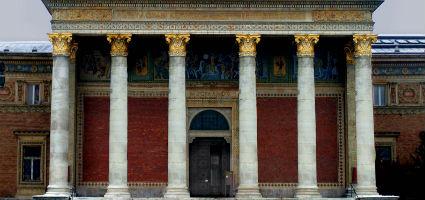2024. September 16. Monday
Kunsthalle - Budapest
 |
Address: 1146, Budapest Dózsa György út 37.
Phone number: (1) 460-7000, (1) 363-2671
E-mail: info@mucsarnok.hu
Opening hours: Tue-Wed 10-18, Thu 12-20, Fri-Sun 10-18
|
Museum tickets, service costs:
|
Ticket for adults
|
1200 HUF
|
|
|
Ticket for adults
(valid for the Kunsthalle and the Ernst Museum)
|
1400 HUF
|
|
|
Group ticket for adults
(from over 10 people)
|
800 HUF
|
/ capita
|
|
Ticket for students
(EU citizens from the age of 6 to 26 )
|
600 HUF
|
|
|
Ticket for students
(valid for the Kunsthalle and the Ernst Museum, 6-26 years of age)
|
700 HUF
|
|
|
Group ticket for students
(from over 10 people)
|
400 HUF
|
/ capita
|
|
Ticket for pensioners
(valid for the Kunsthalle and the Ernst Museum, 62-70 years of age)
|
700 HUF
|
|
|
Ticket for pensioners
(EU citizens from the age of 62 to 70)
|
600 HUF
|
|
|
Ticket for families
(1 adults + 2 children)
|
1800 HUF
|
/ family
|
|
Ticket for families
(2 adults + 2 children)
|
2400 HUF
|
/ family
|
“Apocalypse – upcovery in its original sense – attributes meaning to collapse and invests the past with predictive capacities. When we say décollages are beautiful, we talk about this ourselves.”

János Géczi is one of the last polymaths. A scholar of biology, he has published research on cultural history and anthropology; as a creator, he is known primarily as an author and poet, but his experimentation with artistic visual languages (initially in close association with high literature, gradually becoming increasingly autonomous) also goes back several decades.
The raw materials of his décollages are large posters damaged by time and human intervention, decaying, mouldering, found (stolen!) surfaces stripped of their original function and pasted over repeatedly, which he transforms into art with a minimum of manipulation, tearing, and pasting back.
The term upcovery is borrowed from András Visky’s prefatory text to János Géczi’s exhibition. These works simultaneously involve covering up and revealing something. Original significations are blotted out, voided; the found object is stripped of all specific signs that might carry meaning or offer clues for interpretation. Concurrently, exposing the layers makes decay, metamorphosis, the dimension of time visible and examinable. The works perpetuate an interim condition: peeling and laceration (even accidentally) lead to new signs and patterns developing into a new system, signification, image – as though we were witnessing the frozen moment of disintegration and reorganization. Whether that moment reveals to us something of the operative laws of language, art, culture, an entire civilization, the ecosystem, or even the universe, is up to us, spectators.
Those analysing János Géczi’s art always mention its relation to street art or at least to urban environments and consumer culture. The connection seems evident, indeed, as the artist’s raw material is the poster, a most obvious device and exhibitor of that culture, whose original milieu is the street of the metropolis; the creator’s interventions concurrently use and question the forms and validity of that culture. The Kunsthalle show makes an exciting attempt at bridging the distance between the street and the exhibition hall as well: János Géczi installs a temporary, site-specific artwork on the interior walls, which engages in a dialogue with the outdoor installation placed in front of the façade of the Kunsthalle, visible from the windows of the hall, also destined for the “here and now” alone.

János Géczi is one of the last polymaths. A scholar of biology, he has published research on cultural history and anthropology; as a creator, he is known primarily as an author and poet, but his experimentation with artistic visual languages (initially in close association with high literature, gradually becoming increasingly autonomous) also goes back several decades.
The raw materials of his décollages are large posters damaged by time and human intervention, decaying, mouldering, found (stolen!) surfaces stripped of their original function and pasted over repeatedly, which he transforms into art with a minimum of manipulation, tearing, and pasting back.
The term upcovery is borrowed from András Visky’s prefatory text to János Géczi’s exhibition. These works simultaneously involve covering up and revealing something. Original significations are blotted out, voided; the found object is stripped of all specific signs that might carry meaning or offer clues for interpretation. Concurrently, exposing the layers makes decay, metamorphosis, the dimension of time visible and examinable. The works perpetuate an interim condition: peeling and laceration (even accidentally) lead to new signs and patterns developing into a new system, signification, image – as though we were witnessing the frozen moment of disintegration and reorganization. Whether that moment reveals to us something of the operative laws of language, art, culture, an entire civilization, the ecosystem, or even the universe, is up to us, spectators.
Those analysing János Géczi’s art always mention its relation to street art or at least to urban environments and consumer culture. The connection seems evident, indeed, as the artist’s raw material is the poster, a most obvious device and exhibitor of that culture, whose original milieu is the street of the metropolis; the creator’s interventions concurrently use and question the forms and validity of that culture. The Kunsthalle show makes an exciting attempt at bridging the distance between the street and the exhibition hall as well: János Géczi installs a temporary, site-specific artwork on the interior walls, which engages in a dialogue with the outdoor installation placed in front of the façade of the Kunsthalle, visible from the windows of the hall, also destined for the “here and now” alone.

